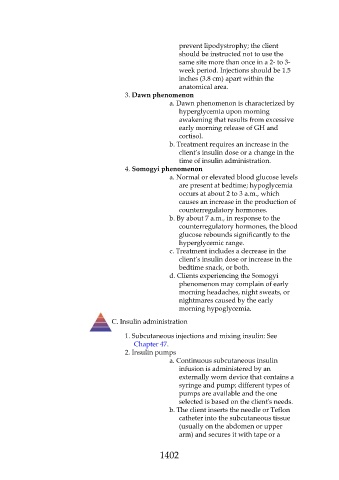Page 1402 - Saunders Comprehensive Review For NCLEX-RN
P. 1402
prevent lipodystrophy; the client
should be instructed not to use the
same site more than once in a 2- to 3-
week period. Injections should be 1.5
inches (3.8 cm) apart within the
anatomical area.
3. Dawn phenomenon
a. Dawn phenomenon is characterized by
hyperglycemia upon morning
awakening that results from excessive
early morning release of GH and
cortisol.
b. Treatment requires an increase in the
client’s insulin dose or a change in the
time of insulin administration.
4. Somogyi phenomenon
a. Normal or elevated blood glucose levels
are present at bedtime; hypoglycemia
occurs at about 2 to 3 a.m., which
causes an increase in the production of
counterregulatory hormones.
b. By about 7 a.m., in response to the
counterregulatory hormones, the blood
glucose rebounds significantly to the
hyperglycemic range.
c. Treatment includes a decrease in the
client’s insulin dose or increase in the
bedtime snack, or both.
d. Clients experiencing the Somogyi
phenomenon may complain of early
morning headaches, night sweats, or
nightmares caused by the early
morning hypoglycemia.
C. Insulin administration
1. Subcutaneous injections and mixing insulin: See
Chapter 47.
2. Insulin pumps
a. Continuous subcutaneous insulin
infusion is administered by an
externally worn device that contains a
syringe and pump; different types of
pumps are available and the one
selected is based on the client's needs.
b. The client inserts the needle or Teflon
catheter into the subcutaneous tissue
(usually on the abdomen or upper
arm) and secures it with tape or a
1402

